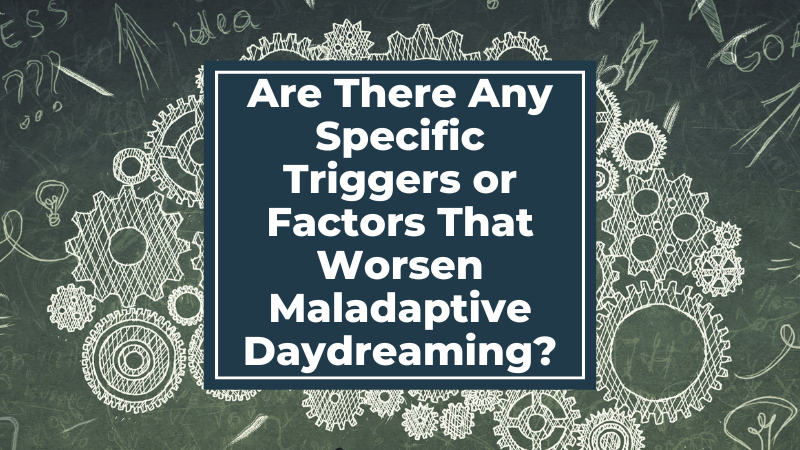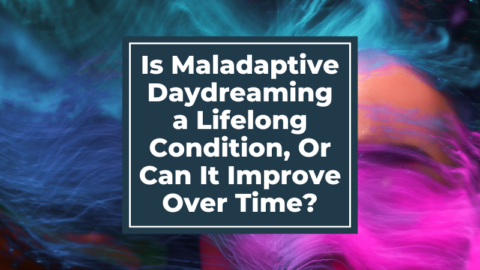For individuals who experience maladaptive daydreaming, the constant presence of vivid and immersive daydreams can disrupt daily life and hinder productivity. Understanding the triggers and factors that exacerbate maladaptive daydreaming is crucial in developing effective strategies for managing this condition.
While triggers can vary from person to person, there are common elements that contribute to the intensification of excessive daydreaming. Exploring these triggers and factors provides valuable insights into the complex nature of maladaptive daydreaming and equips individuals with the knowledge to regain control over their daydreaming tendencies.
In this article, we delve into the triggers and factors that make maladaptive daydreaming worse, shedding light on the various aspects that contribute to its intensity. We will explore emotional triggers, environmental cues, personal factors, and the role of certain activities or situations. By understanding these underlying factors, individuals affected by maladaptive daydreaming can begin to identify their own triggers and develop personalized coping strategies to navigate the challenges associated with excessive daydreaming.
What Is a Trigger When Talking About Maladaptive Daydreaming
In the context of maladaptive daydreaming, triggers are stimuli or cues that initiate or intensify the urge to engage in excessive daydreaming. These triggers can vary from person to person but often include emotional distress, solitude or isolation, repetitive or monotonous tasks, environmental cues, and media or entertainment.
Strong emotions like stress or sadness, as well as being alone or feeling socially isolated, can prompt the need for escapism through daydreaming. Engaging in repetitive or mundane activities may trigger daydreaming as a way to alleviate boredom, while certain environmental cues or media content can evoke vivid daydreaming experiences.
Identifying personal triggers is crucial in managing maladaptive daydreaming, as it allows individuals to develop strategies to minimize their impact or find alternative coping mechanisms. Understanding these triggers can empower individuals to regain control over their daydreaming habits and lead a more balanced life.
15 Common Triggers for Maladaptive Daydreaming
While triggers and factors that worsen maladaptive daydreaming can vary from person to person, there are some common elements that may contribute to its exacerbation. These include:
1. Emotional Disturbances or Distress
Emotional disturbances and distress can be significant triggers for maladaptive daydreaming. When individuals experience emotional turmoil, such as stress, anxiety, depression, or loneliness, they may seek a coping mechanism to escape or alleviate these negative emotions. Maladaptive daydreaming can serve as a way to temporarily detach from reality and immerse oneself in a more desirable and comforting mental world.
The vivid and elaborate daydreams provide a sense of emotional release, a means of processing difficult emotions, and a temporary reprieve from real-life challenges. Engaging in maladaptive daydreaming can create a temporary emotional refuge, where individuals can control and shape their experiences and emotions within the realm of their fantasies.
The emotional disturbances and distress can act as triggers by prompting individuals to seek solace in daydreaming, which provides a temporary escape from the underlying emotional pain. It is important to recognize that while maladaptive daydreaming may provide temporary relief, it does not address the root causes of the emotional disturbances. In fact, excessive daydreaming can perpetuate a cycle of avoidance, inhibiting individuals from effectively confronting and resolving their emotional challenges.
Understanding the connection between emotional disturbances and maladaptive daydreaming is crucial in developing strategies for managing the condition. By addressing and seeking support for the underlying emotional distress, individuals can reduce the reliance on maladaptive daydreaming as a coping mechanism and explore healthier ways to process and manage their emotions.
2. Boredom and Monotony
Boredom and monotony can serve as triggers for maladaptive daydreaming. When individuals find themselves in mundane or repetitive situations, such as during long periods of inactivity, unstimulating tasks, or a lack of external stimulation, they may turn to daydreaming as a way to alleviate the boredom and escape the monotony of their current environment.
Maladaptive daydreaming offers a form of entertainment and mental stimulation that can be more engaging and exciting than the present reality. It allows individuals to create vivid and elaborate narratives in their minds, transporting themselves to imaginary worlds where they can experience novelty, adventure, and emotional intensity.
The lack of external stimuli or engaging activities can leave individuals feeling restless, unfulfilled, and craving mental stimulation. Maladaptive daydreaming becomes a way to fill this void and create a sense of excitement and engagement, effectively breaking the monotony of their surroundings.
It is important to note that while daydreaming can provide temporary relief from boredom, it may interfere with productivity, attention, and the ability to fully engage in real-life activities. Excessive daydreaming can lead to a cycle of avoidance, where individuals prioritize their daydreaming over essential responsibilities and meaningful interactions.
To manage maladaptive daydreaming triggered by boredom and monotony, individuals can focus on incorporating more stimulating and fulfilling activities into their daily routines. This may involve seeking out new hobbies, pursuing interests, engaging in physical exercise, or setting goals that provide a sense of purpose and accomplishment. By actively addressing and diversifying their experiences, individuals can reduce their reliance on maladaptive daydreaming as a means of escape and find healthier outlets for fulfillment and engagement.
3. Isolation or Social Withdrawal
Isolation and social withdrawal can act as triggers for maladaptive daydreaming. When individuals experience feelings of loneliness, disconnection, or a lack of social interaction, they may turn to daydreaming as a way to compensate for the absence of real-life connections and social engagement.
Maladaptive daydreaming offers a means of escaping the feelings of isolation and filling the void of social interaction. Through daydreaming, individuals can create and immerse themselves in social scenarios, imaginary relationships, and interactions that provide a sense of companionship, acceptance, and emotional connection.
Isolation and social withdrawal can stem from various factors such as shyness, social anxiety, a lack of social skills, or challenging life circumstances that limit social opportunities. Individuals who struggle with forming and maintaining real-life relationships may find solace in the world of daydreams, where they can control the social dynamics and experience a sense of belonging.
While daydreaming can temporarily alleviate feelings of isolation, it is important to address the underlying causes and seek healthy social connections. Developing social skills, building support networks, seeking professional help for social anxiety, and engaging in social activities can help individuals reduce their reliance on maladaptive daydreaming and foster meaningful relationships in the real world.
By addressing the triggers of isolation and social withdrawal, individuals can work towards creating a more fulfilling and connected life, reducing the need to escape into excessive daydreaming and cultivating healthier social interactions.
4. Escapism and Traumatic Experiences
Escapism and traumatic experiences can act as triggers for maladaptive daydreaming. Maladaptive daydreaming often serves as a coping mechanism for individuals who seek to escape from distressing emotions, painful memories, or overwhelming situations. Traumatic experiences, such as abuse, loss, or significant life events, can leave deep emotional scars and create a strong desire to retreat into a world of fantasy and imagination.
For those who have experienced trauma or are struggling with emotional distress, daydreaming provides a means of dissociation from reality and a temporary respite from negative emotions. The vivid and immersive nature of daydreams allows individuals to create alternate narratives or scenarios that offer solace, control, or a sense of comfort that may be lacking in their real lives.
Escapism, whether triggered by traumatic experiences or simply the desire to avoid the challenges of daily life, can become a pattern of maladaptive daydreaming when it interferes with one’s ability to function, engage in real-life relationships, or meet responsibilities and obligations. Excessive daydreaming as a form of escapism can become a way to avoid confronting difficult emotions, addressing underlying issues, or seeking appropriate support.
To address the trigger of escapism and traumatic experiences in maladaptive daydreaming, it is crucial to work on healing from past traumas and developing healthy coping strategies. This may involve seeking therapy or counseling to process and resolve emotional wounds, learning effective stress management techniques, and developing healthier ways to manage difficult emotions. By addressing the root causes and finding healthier coping mechanisms, individuals can reduce the need for excessive daydreaming as a means of escape and create a more balanced and fulfilling emotional life.
5. Dissatisfaction with Reality
Dissatisfaction with reality can be a significant trigger for maladaptive daydreaming. When individuals feel dissatisfied or unfulfilled with their current circumstances, relationships, or personal achievements, they may seek solace and fulfillment through immersive daydreaming. The dissatisfaction with reality could stem from various sources, such as unmet aspirations, unfulfilled desires, or a general sense of dissatisfaction with one’s life.
Maladaptive daydreaming provides an escape from the perceived limitations or disappointments of real life. It allows individuals to create idealized versions of themselves, relationships, or situations in their daydreams, where they can experience success, happiness, or adventure that they may feel is lacking in reality. The vivid and detailed nature of these daydreams can be appealing and provide temporary relief from the discontentment with their actual circumstances.
However, relying excessively on daydreaming as a way to cope with dissatisfaction can exacerbate the problem. It can further disconnect individuals from reality and hinder their ability to take constructive actions to improve their lives. Instead of addressing the underlying issues causing dissatisfaction, maladaptive daydreaming becomes a way to avoid confronting and actively working on finding real-life solutions.
To manage the trigger of dissatisfaction with reality, it is important to engage in self-reflection and identify the specific areas of dissatisfaction. This process may involve setting realistic goals, exploring personal values and interests, and taking steps toward creating a more fulfilling and satisfying life. Seeking support from a therapist or counselor can also be helpful in gaining insights, developing coping strategies, and fostering a positive mindset. By addressing the underlying dissatisfaction and working towards positive changes in real life, individuals can reduce the need for excessive daydreaming as an escape and find greater fulfillment in their actual experiences.
6. Lack of Structure or Routine
A lack of structure or routine in one’s daily life can be a trigger for maladaptive daydreaming. When there is a lack of clear goals, responsibilities, or a well-defined schedule, individuals may find themselves with excess time and freedom, which can lead to unproductive daydreaming. Without a structured routine, there may be a sense of aimlessness or boredom, leaving individuals more prone to getting lost in elaborate daydreams as a means of filling the void or passing the time.
Having a structured routine provides a sense of purpose, direction, and stability in daily life. It helps individuals stay focused, productive, and engaged in meaningful activities. A lack of structure can disrupt this balance, creating a void that maladaptive daydreaming may fill. When there are no specific tasks or activities to occupy one’s time, daydreaming can become a default activity to escape boredom or lack of stimulation.
Establishing a structured routine can help manage this trigger. Setting clear goals, creating a schedule, and allocating time for productive activities can provide a sense of purpose and direction. This can involve planning daily tasks, engaging in hobbies or interests, pursuing personal or professional goals, and incorporating regular physical activity or social interactions into the routine. By having a well-structured and purposeful daily life, individuals can minimize the gaps where daydreaming may be more likely to occur and instead channel their time and energy into meaningful and fulfilling activities.
7. Enabling Environments
Enabling environments can contribute to the trigger of maladaptive daydreaming. An enabling environment refers to a set of circumstances or conditions that support or facilitate a behavior, in this case, excessive daydreaming. Several factors within an environment can enable maladaptive daydreaming tendencies.
One aspect of an enabling environment is the availability of uninterrupted and private spaces. When individuals have easy access to secluded spaces where they can daydream without interruption or external distractions, it can encourage the indulgence in excessive daydreaming. These spaces may include a private room, a quiet corner, or even virtual spaces where individuals can immerse themselves in their daydreams without interference.
Moreover, the presence of certain objects or stimuli can also enable maladaptive daydreaming. For example, having access to electronic devices, such as smartphones or tablets, with various entertainment options can trigger daydreaming behaviors. Similarly, engaging with media content, such as books, movies, or music, that resonates with one’s daydreaming fantasies can reinforce and encourage the habit.
Social factors can also contribute to an enabling environment for maladaptive daydreaming. Being surrounded by individuals who share similar daydreaming tendencies or who encourage and validate excessive daydreaming can reinforce the behavior. Social isolation or a lack of meaningful connections can also create an enabling environment, as individuals may turn to daydreaming as a coping mechanism or source of emotional fulfillment.
Recognizing and addressing enabling factors in the environment is crucial in managing maladaptive daydreaming. This may involve creating a more structured and balanced environment, setting boundaries with personal devices or media consumption, seeking social support, and cultivating healthier coping mechanisms for emotional fulfillment and stress management. By modifying the environment to be less enabling, individuals can reduce the triggers and create a setting that supports healthier habits and behaviors.
8. Excessive Media Consumption
Excessive media consumption can indeed be a trigger for maladaptive daydreaming. In today’s digital age, where various forms of media are readily available, individuals may find themselves consuming excessive amounts of media content, such as movies, TV shows, books, or video games. This constant exposure to captivating narratives and imaginative worlds can fuel the tendency to engage in excessive daydreaming.
Media content often provides an escape from reality and offers compelling storylines and characters that capture the imagination. This can be especially appealing for individuals prone to maladaptive daydreaming, as it offers an opportunity to immerse themselves in vivid and elaborate daydreams that align with the themes and narratives they encounter in media.
Additionally, media consumption can create a cycle of reinforcement. Engaging with media content that resonates with one’s daydreaming fantasies can reinforce and validate the habit of excessive daydreaming. The more individuals indulge in media consumption that aligns with their daydreaming themes, the more their daydreaming tendencies may be amplified.
Furthermore, excessive media consumption can lead to a sedentary lifestyle and decreased engagement with real-world activities and social interactions. This withdrawal from real-life experiences can create a void that individuals attempt to fill through daydreaming. The more time individuals spend consuming media, the less time they have for real-life activities, leading to an increased reliance on daydreaming as a source of entertainment, connection, or emotional fulfillment.
To address the trigger of excessive media consumption, it is important to establish a healthy balance between media consumption and real-life engagement. This may involve setting limits on screen time, diversifying leisure activities to include physical exercise, hobbies, and social interactions, and consciously choosing media content that promotes mindfulness and engagement with the present moment rather than escapism. By creating a healthier relationship with media consumption, individuals can reduce the trigger for maladaptive daydreaming and cultivate a more balanced and fulfilling lifestyle.
9. Music
Music can be a powerful trigger for maladaptive daydreaming due to its ability to evoke strong emotions and stimulate the imagination. The combination of melodies, lyrics, and rhythm can create a sensory experience that transports individuals into a different mental state, facilitating the onset of daydreaming episodes.
Certain types of music, particularly those with immersive and evocative qualities, may resonate deeply with individuals prone to maladaptive daydreaming. The lyrics, themes, or overall atmosphere of the music can align with their daydreaming narratives or provide an emotional escape from reality. As a result, listening to music becomes a catalyst for entering a prolonged state of daydreaming.
Music’s ability to elicit emotions and trigger memories can also contribute to maladaptive daydreaming. Certain songs or genres may evoke specific emotions or memories, prompting individuals to retreat into their daydreams as a means of processing or escaping from those emotions or memories. The music serves as a trigger that activates their daydreaming tendencies.
Furthermore, music can serve as a background or accompaniment to daydreaming sessions, enhancing the immersive experience. People may intentionally create playlists or seek out specific songs that align with their daydreaming themes, intensifying the emotional connection and providing a soundtrack to their fantasies.
To manage the trigger of music for maladaptive daydreaming, individuals can practice mindfulness and awareness when listening to music. This involves being present in the moment, focusing on the music itself rather than getting lost in daydreams. Additionally, diversifying music choices and exploring genres that promote a more grounded and present mindset can help reduce the inclination to daydream excessively.
10. Avoidance or Procrastination
Avoidance and procrastination can serve as triggers for maladaptive daydreaming by creating an environment that fosters escapism and the desire to mentally withdraw from tasks or responsibilities. When faced with challenging or unpleasant situations, individuals may find solace in daydreaming as a means of avoiding the discomfort or anxiety associated with those tasks.
Avoidance behaviors involve actively evading or postponing tasks or obligations, often driven by fear, anxiety, or a desire to escape from negative emotions. This can include avoiding responsibilities at work, neglecting personal relationships, or disregarding important life tasks. As individuals engage in avoidance, the mind may naturally seek out alternative realities through daydreaming as a coping mechanism.
Procrastination, on the other hand, refers to the tendency to delay or postpone tasks that require immediate attention. Procrastinators may feel overwhelmed or anxious about starting or completing tasks, leading them to seek refuge in daydreaming instead. The act of daydreaming provides a temporary respite from the stress or pressure associated with taking action, allowing individuals to escape into a world of imagination and fantasy.
Both avoidance and procrastination create a pattern of delaying or avoiding real-life responsibilities, perpetuating a cycle of maladaptive daydreaming. This behavior can become problematic when it interferes with productivity, goal attainment, and overall well-being.
To address the triggers of avoidance and procrastination for maladaptive daydreaming, individuals can focus on developing healthy coping strategies and time management techniques. This may involve breaking tasks into smaller, manageable steps, setting realistic goals, and using strategies such as time blocking or prioritization. Seeking support from therapists, counselors, or coaches can also be beneficial in addressing underlying issues that contribute to avoidance and procrastination tendencies.
By cultivating a proactive and structured approach to tasks and responsibilities, individuals can reduce the inclination to engage in excessive daydreaming as a form of avoidance or procrastination. It is important to recognize the underlying reasons behind these behaviors and address them in order to break the cycle and foster a more productive and fulfilling life.
11. Lack of Awareness and Control
A lack of awareness and control can serve as a trigger for maladaptive daydreaming by allowing the mind to wander aimlessly without conscious regulation. When individuals are not fully aware of their thought patterns or do not have a strong sense of control over their mental processes, daydreaming can easily become excessive and unproductive.
One aspect of maladaptive daydreaming is the inability to consciously direct or limit the duration and intensity of daydreaming episodes. This lack of control can stem from various factors, such as a tendency towards mind-wandering, difficulty in focusing attention, or a lack of mindfulness in the present moment. Without a conscious effort to stay grounded and engaged in reality, the mind may slip into extended periods of daydreaming, leading to an increased risk of maladaptive daydreaming.
Additionally, a lack of awareness about the negative consequences or impact of excessive daydreaming can perpetuate the behavior. Some individuals may not recognize the extent to which daydreaming hinders their productivity, interferes with relationships, or contributes to a sense of dissatisfaction with reality. Without this awareness, there is little motivation to address and manage the daydreaming tendencies.
To address the triggers related to a lack of awareness and control in maladaptive daydreaming, individuals can work on cultivating mindfulness and developing self-regulation techniques. Mindfulness practices, such as meditation or mindfulness exercises, can help improve awareness of one’s thoughts, emotions, and behaviors. By becoming more attuned to the present moment, individuals can catch themselves when their mind begins to wander and consciously redirect their attention.
Building self-control and self-discipline is also important in managing maladaptive daydreaming. This can involve setting specific goals and timelines for completing tasks, practicing time management techniques, and implementing strategies to stay focused and engaged. Developing a routine that includes regular breaks, physical activity, and structured periods of focused work can help individuals maintain better control over their thought processes and reduce the frequency and intensity of daydreaming episodes.
By enhancing awareness and cultivating greater control over one’s mental processes, individuals can reduce the triggers associated with a lack of awareness and control in maladaptive daydreaming. This allows for a more balanced and intentional approach to daydreaming, enabling individuals to better manage their time, energy, and engagement with the real world.
12. Difficulty with Real-Life Relationships
Difficulty with real-life relationships can serve as a trigger for maladaptive daydreaming due to the escapism and emotional fulfillment that daydreaming can provide. When individuals experience challenges or dissatisfaction in their relationships, whether it be romantic, familial, or social connections, they may seek solace in the fantasy world of daydreams as a means of escape.
Maladaptive daydreaming can offer a sense of control, connection, and idealized relationships that may be lacking in real life. It allows individuals to create and immerse themselves in elaborate narratives where they have more control over their interactions, experiences, and outcomes. This can be particularly appealing for individuals who feel lonely, misunderstood, or dissatisfied with their real-life relationships.
Additionally, maladaptive daydreaming can serve as a coping mechanism for dealing with the emotional distress and disappointment that can arise from challenging relationships. It provides a way to escape from the pain, conflicts, and complexities of real-life interactions, offering a temporary respite and a source of emotional comfort.
The immersive nature of daydreaming can also lead individuals to withdraw from real-life relationships. Spending excessive amounts of time lost in daydreams may result in neglecting social interactions, missing opportunities for connection, or experiencing difficulty in maintaining meaningful relationships. This withdrawal can further exacerbate feelings of isolation and dissatisfaction with real-life relationships, perpetuating the cycle of seeking solace in daydreaming.
To address the triggers associated with difficulty in real-life relationships and maladaptive daydreaming, it is important for individuals to actively work on improving their real-life connections and communication skills. This may involve seeking support from trusted friends, family, or mental health professionals to navigate relationship challenges, developing better social skills and emotional intelligence, and exploring strategies for building healthy, fulfilling relationships.
Engaging in activities that promote social interaction and connection, such as joining clubs, volunteering, or participating in group activities, can also help alleviate feelings of isolation and provide opportunities to develop meaningful connections. Seeking therapy or counseling can be beneficial in addressing underlying emotional issues and developing healthier coping mechanisms for relationship challenges.
By addressing and improving real-life relationships, individuals can reduce the need for excessive daydreaming as an escape and find fulfillment and satisfaction in their interpersonal connections. This, in turn, can help manage the triggers associated with difficulty in real-life relationships and contribute to a healthier balance between daydreaming and engagement with the real world.
13. Perfectionism or High Achievement Orientation
Perfectionism or a high achievement orientation can be a trigger for maladaptive daydreaming due to the pressure and expectations individuals place on themselves. Perfectionists often have exceptionally high standards for themselves and strive for flawlessness in various aspects of their lives. This constant pursuit of perfection can lead to feelings of stress, anxiety, and dissatisfaction when they perceive themselves as falling short of their own expectations.
Maladaptive daydreaming can offer an escape from the pressures and demands of real-life responsibilities and the relentless pursuit of perfection. It provides a space where individuals can create idealized versions of themselves and explore scenarios where they effortlessly achieve their goals and receive recognition and validation.
Daydreaming allows perfectionists to experience a sense of control over their achievements and outcomes, as they can envision scenarios where everything goes according to plan. It offers temporary relief from the self-critical thoughts and feelings of failure that can accompany the high standards perfectionists set for themselves.
Furthermore, maladaptive daydreaming can serve as a coping mechanism for managing the anxiety and stress associated with perfectionism. Engaging in elaborate daydreams can provide a soothing and comforting escape from the relentless self-evaluation and fear of failure that perfectionists often experience. It offers a way to temporarily alleviate the pressure and create a sense of accomplishment and satisfaction.
However, relying on maladaptive daydreaming as a coping mechanism can further perpetuate the cycle of perfectionism. It can become a form of avoidance, preventing individuals from taking real-life actions to achieve their goals and fulfill their aspirations. Instead of engaging in productive efforts, they may spend excessive amounts of time lost in daydreams, which ultimately hinders their progress and perpetuates feelings of dissatisfaction.
To address the triggers associated with perfectionism and maladaptive daydreaming, it is important for individuals to develop healthier coping strategies and shift their mindset towards more realistic expectations. This may involve challenging perfectionistic tendencies, setting achievable goals, and learning to accept imperfections and mistakes as part of the learning process.
Working on self-compassion and self-acceptance is crucial in breaking the cycle of perfectionism and reducing the need for excessive daydreaming as an escape. Seeking support from therapists or counselors who specialize in perfectionism and high-achieving individuals can provide valuable insights and tools for managing perfectionistic tendencies and developing healthier perspectives on success.
Engaging in activities that promote self-care, stress reduction, and relaxation can also help manage the triggers associated with perfectionism. This may include practicing mindfulness, engaging in physical exercise, pursuing hobbies, and establishing healthy boundaries to create a more balanced lifestyle.
By addressing perfectionistic tendencies and developing healthier coping strategies, individuals can reduce the reliance on maladaptive daydreaming as an escape and channel their energy and focus towards productive endeavors. This can lead to a greater sense of satisfaction and fulfillment in real-life achievements, ultimately reducing the need for excessive daydreaming.
14. Lack of Effective Coping Mechanisms
A lack of effective coping mechanisms can serve as a trigger for maladaptive daydreaming. When individuals struggle to cope with stress, overwhelming emotions, or challenging situations, they may turn to daydreaming as a way to escape and cope with these difficulties. Here’s how a lack of effective coping mechanisms can contribute to maladaptive daydreaming:
- Emotional Regulation: When faced with intense emotions like anxiety, sadness, or anger, individuals may resort to maladaptive daydreaming as a way to temporarily avoid or suppress those emotions. Daydreaming can provide a soothing and comforting outlet, allowing individuals to detach from their immediate reality and immerse themselves in a more pleasant or controllable world.
- Stress Relief: Excessive stress can overwhelm individuals and leave them feeling helpless or trapped. In the absence of healthy stress management techniques, some individuals may turn to daydreaming as a means of stress relief. It provides a temporary escape from the pressures of daily life and offers a sense of control and relaxation.
- Avoidance of Problems: Maladaptive daydreaming can also function as a means of avoiding real-life problems or difficult situations. Instead of confronting and addressing challenges head-on, individuals may retreat into their daydreams to avoid facing the reality of their problems. This avoidance can prevent individuals from developing effective problem-solving skills and hinder personal growth.
- Lack of Coping Strategies: If individuals have not learned or developed healthy coping mechanisms to deal with life stressors, they may default to maladaptive daydreaming as their primary coping strategy. This can be especially true when they lack awareness of alternative coping methods or when they haven’t had the opportunity to build resilience and adaptive skills.
- Self-Soothing and Comfort: Maladaptive daydreaming can provide a sense of comfort and self-soothing. When individuals feel lonely, isolated, or unsupported, daydreaming can serve as a source of companionship, fulfillment, and emotional nourishment. It allows individuals to create and engage with idealized characters or situations that meet their emotional needs.
To address maladaptive daydreaming triggered by a lack of effective coping mechanisms, it is crucial to develop healthier coping strategies. This may involve seeking therapy or counseling to learn constructive ways to manage stress, regulate emotions, and problem-solve. Building resilience, practicing mindfulness, engaging in self-care activities, and developing healthy support networks can also help individuals develop more adaptive coping mechanisms and reduce reliance on maladaptive daydreaming as a coping strategy.
15. Reinforcement and Reward
Positive reinforcement from daydreaming, such as experiencing pleasure, excitement, or a sense of accomplishment, can reinforce the behavior and make it more difficult to break the cycle of maladaptive daydreaming. The brain’s reward system may become wired to seek the gratification provided by daydreaming, reinforcing its compulsive nature.
Individuals may experience a surge in dopamine when engaged in vivid and immersive daydreams. The pleasurable and rewarding aspects of daydreaming can reinforce the behavior, leading to a cycle of excessive and compulsive daydreaming.
Various factors can contribute to a dopamine boost during daydreaming, such as emotionally charged scenarios, fantasies of success or accomplishment, or imagining idealized versions of oneself. These dopamine-inducing experiences can act as triggers for maladaptive daydreaming, prompting individuals to escape into vivid and elaborate daydreams to seek the pleasurable feelings associated with dopamine release.
It’s important to note that these triggers and factors can vary from person to person, and individuals may experience a combination of different influences. Recognizing and understanding these triggers can assist individuals in developing personalized strategies to manage maladaptive daydreaming and create a healthier balance between fantasy and reality.
How Understanding Maladaptive Daydreaming Triggers Can Help You Get Control Back
Identifying and utilizing triggers can be a powerful tool in managing maladaptive daydreaming. By understanding the specific factors that contribute to excessive daydreaming episodes, individuals can develop strategies to regain control of maladaptive daydreaming and redirect their focus toward more productive and fulfilling activities.
Here are some steps to identify and use your triggers to better manage maladaptive daydreaming:
- Self-reflection: Take time to reflect on your daydreaming patterns and explore the situations, emotions, or thoughts that tend to trigger excessive daydreaming. Notice any recurring themes, locations, or activities that precede your daydreaming episodes.
- Awareness of emotions: Pay attention to your emotional state when daydreaming intensifies. Are you experiencing boredom, stress, anxiety, or loneliness? Emotions often act as triggers for maladaptive daydreaming, and recognizing the underlying feelings can help you address them in healthier ways.
- Environmental cues: Identify specific environmental cues that prompt daydreamings, such as certain places, objects, or sounds. These cues can act as triggers and signal your brain to slip into a daydreaming state. Being aware of these cues can help you modify your environment or develop strategies to redirect your attention.
- Journaling: Maintain a journal to track your daydreaming episodes and the triggers associated with them. Record the time, location, emotions, and any specific events or thoughts that preceded the daydreaming. Over time, patterns may emerge, allowing you to gain deeper insight into your triggers.
- Mindfulness techniques: Practice mindfulness techniques, such as deep breathing, meditation, or grounding exercises, to enhance your present-moment awareness. These techniques can help you recognize when you’re entering a daydreaming state and bring your focus back to the present.
- Cognitive strategies: Use cognitive strategies to challenge unhelpful thoughts and redirect your attention. When you notice daydreaming tendencies, remind yourself of your goals, engage in stimulating activities, or practice positive self-talk to refocus your mind.
- Create alternative outlets: Find alternative outlets for your creative imagination and emotional expression. Engage in hobbies, such as writing, drawing, or music, that provide a constructive way to channel your imagination and emotions, reducing the need for excessive daydreaming.
- Seek support: Consider reaching out to mental health professionals, support groups, or online communities specializing in maladaptive daydreaming. They can provide guidance, validation, and practical tips for managing triggers and developing healthier coping mechanisms.
By identifying and using your triggers, you can gain a better understanding of your maladaptive daydreaming patterns and develop personalized strategies for managing and redirecting your daydreaming tendencies. Remember, it is a gradual process, and with patience, self-compassion, and a proactive approach, you can regain control over your daydreaming habits and live a more fulfilling and balanced life.
In Conclusion: Maladaptive Daydreaming Triggers are Just One Part of the Puzzle
The impact of maladaptive daydreaming on individuals’ lives can be significant, often leading to distress and impairment. Recognizing the triggers and factors that worsen maladaptive daydreaming is an essential step toward effectively managing this condition. By identifying these triggers and understanding their influence, individuals can develop personalized strategies to regain control over their daydreaming tendencies and minimize the negative impact on their daily functioning.
While each person’s experience of maladaptive daydreaming is unique, common triggers such as emotional distress, environmental cues, personal factors, and specific activities or situations can contribute to the intensification of excessive daydreaming. Through self-reflection, self-awareness, and seeking professional guidance, individuals can gain a deeper understanding of their triggers and work towards developing healthier coping mechanisms.
It is important to remember that managing maladaptive daydreaming is a journey that requires patience, persistence, and self-compassion. With the support of mental health professionals, loved ones, and a commitment to self-care, individuals affected by maladaptive daydreaming can navigate the challenges they face and find a sense of balance in their lives.
By continuing to explore and raise awareness about the triggers and factors that exacerbate maladaptive daydreaming, we can foster a greater understanding of this condition and promote the development of targeted interventions and support systems. Together, we can create a more empathetic and informed society that provides the necessary resources for individuals to manage and overcome the challenges associated with maladaptive daydreaming.
Discuss your triggers and methods and techniques for overcoming them with other maladaptive daydreamers on the Maladaptive Daydreaming Forum.









